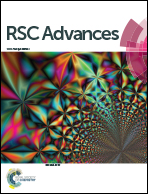Sulfur/bamboo charcoal composites cathode for lithium–sulfur batteries
Abstract
Herein, sulfur/bamboo charcoal (S/BC) composites with a sulfur content of 57.7 wt% were prepared by melt–diffusion method as cathode materials for Li–S batteries. An initial specific discharge capacity of 685 mA h g−1 and a reversible capacity of 414 mA h g−1 were obtained after 500 cycles at a 0.5 C (1 C = 1675 mA g−1) rate, with only 0.079% capacity fade. Meanwhile, the S/BC cathode can deliver a stable discharge capacity at the current density from 0.1 C to 3 C. The improved cycle stability and rate capability of the S/BC composite cathode materials can be attributed to the well-connected, highly ordered porous structure of BC and the self-deposited passivation layer on Li anode.


 Please wait while we load your content...
Please wait while we load your content...